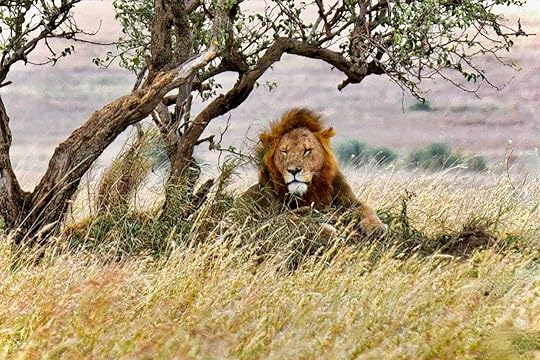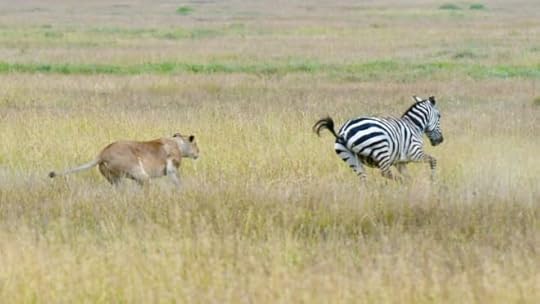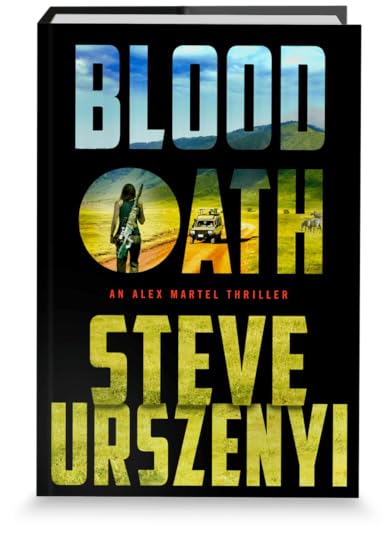Into the Heart of Africa: Part 5
“Serengeti is Maasai for ‘endless plains,’” I wrote in my journal on Tuesday, June 11th. “The scenery was so stark and beautiful—as far as the eye could see, there was nothing but flat plains.”

Standing at the entrance to Serengeti National Park after leaving the Maasai village and Oldupai Gorge that morning, I felt something shift inside me. This wasn’t just another destination on our safari itinerary. This was the place where humanity first stood upright and looked out at the horizon. This was where Blood Oath would find its soul.
Where It All BeganOur stop at Olduvai Gorge earlier that day had been more than a tourist attraction—it was a pilgrimage to the birthplace of human consciousness. Here, in this 30-mile-long ravine carved through ancient volcanic layers, Louis and Mary Leakey made discoveries that changed our understanding of who we are.
In 1959, Mary Leakey found the fossilized skull of Zinjanthropus boisei (later reclassified as Paranthropus boisei), a 1.75-million-year-old hominid nicknamed “Nutcracker Man” for its massive molars. The following year, they discovered Homo habilis—“handy human”—believed to be the first toolmaker, dating back two million years.
The museum-like displays at Olduvai explained the history of Homo sapiens and the Leakeys’ revolutionary work. But what struck me most wasn’t the fossils themselves. It was standing in the place where our ancestors first became human, where they first made tools, first organized hunts, first developed the bonds of family and tribe that would define our species.
These ancient humans survived in the same landscape we were about to enter: the Serengeti, where predator and prey have engaged in their eternal dance for millions of years.
The Place Where Land Runs ForeverSerengeti—the word itself is poetry. In the Maasai language, it means “endless plains” or “the place where the land runs on forever.” Covering 5,700 square miles (14,750 square kilometers) of grassland plains, savanna, riverine forests, and woodlands, the Serengeti is one of the largest and oldest parks in Africa.
As we drove into the park and had our box lunch at the entrance, I began to understand what “endless” truly meant. The horizon stretched in every direction without interruption. No mountains to break the view. No forests to obscure the distance. Just grass and sky meeting somewhere beyond comprehension.
“The scenery was so stark and beautiful,” I noted. This wasn’t the lush abundance of Tarangire or the dramatic amphitheater of Ngorongoro. This was something primal—a landscape that hadn’t changed since those first humans stood upright and gazed across the same plains.

The scenery shifted as we drove—from sparse scrubland to longer grassland to trees and mountains that marked the Great Rift Valley, to kopjes that rose from the plains like rocky islands in a sea of grass. These ancient granite outcrops, some over 500 million years old, thrust upward through the volcanic soil, their weathered surfaces offering refuge to predators and prey alike. But always, that sense of vastness remained.
You could see forever, and forever looked back at you.
Lions on the HuntWithin an hour of entering the park, we came across a pride of lions hunting zebra. The encounter would later inspire one of the most intense sequences in Blood Oath.
Four lions worked in coordinated silence. The female led the stalk, keeping low as she crept toward outlying zebra, closing the distance foot by careful foot. She got to within 20-30 feet before exploding into a sprint, chasing her target for about 50 yards and closing to within 3-4 feet of its hindquarters before the zebra’s superior endurance won the race, the drama unfolding virtually beside our jeep.

“Incredible to see,” I wrote, my hand probably still shaking from the adrenaline.
Watching that hunt unfold, I understood something crucial about predation: it’s not about strength or speed alone. It’s about patience, strategy, and accepting that most hunts fail. The lions would try again. And again. Until finally, hunger or opportunity aligned and they succeeded.
In Blood Oath, when Alex Martel pursues her father’s kidnappers across East Africa, she employs the same relentless patience. She fails multiple times. The kidnappers escape. Opportunities slip away. But like lions, she keeps hunting because survival demands it.
The Great MigrationWe saw giraffes, all types of antelopes, zebra, and wildebeest—big herds that were part of the Great Migration, that spectacular phenomenon where over 1.2 million wildebeest, 300,000 zebra, and thousands of other animals move in an endless cycle through the Serengeti-Mara ecosystem.
The migration follows ancient routes dictated by rainfall and the growth of new grass. The animals travel 800 to 1,000 kilometers in their annual circuit, facing predators at every turn: lions, leopards, cheetahs, hyenas, wild dogs, and crocodiles waiting at river crossings.
We had arrived at the tail end of this massive movement. James told us these were “the last part of the great migration” we were witnessing. But even the stragglers numbered in the thousands, their collective presence a reminder of how life persists through movement, adaptation, and the willingness to face danger for the promise of survival.
Hidden Predators and Ancient RocksWe saw elephants way off in the distance, hippos in a marshy pond, and the eye of a crocodile in the same water—motionless, patient, deadly. High atop one of the kopjes, we spotted a young leopard, so perfectly camouflaged against the ancient granite that even James had difficulty pointing her out. She had returned from a night hunt and was calling to her cubs, the low rumble inviting them to rendezvous among the cracks and caverns of the rock outcrop.

Watching her survey the plains from that elevated vantage point, I understood why these rock formations would become so significant in Blood Oath. In a landscape of endless flatness, the kopjes offer the only strategic high ground—perfect for observation, ambush, and refuge. In Blood Oath, they would become sites where hunters become the hunted, where desperate stands are made, where survival depends on understanding that in the Serengeti, elevation equals advantage.
We also saw the Topi, a large antelope we hadn’t encountered yet, along with waterbuck, warthogs, ostriches, dik-diks, impalas, and gazelles. The biodiversity was staggering—proof that “endless plains” doesn’t mean empty plains.
The Lodge at the End of the WorldWhen we arrived at the Serena Serengeti Lodge around 4 PM, I felt like I’d reached the edge of civilization. The lodge was beautiful—we stayed in round huts with thatched roofs that looked like Maasai houses. The main lodge featured a gorgeous infinity pool that seemed to spill directly into the savannah.
But beauty came with constant reminders of danger. “We need an escort once it’s dark to take us from our room to the main lodge due to danger from the wild animals. Current risk is a cape buffalo that comes at dusk to drink from the pool.”
This detail—needing escorts to walk between buildings after dark—would become integral to Blood Oath’s atmosphere. Even in places designed for human comfort and safety, the wild remains in control. The buffalo doesn’t recognize property lines or respect human schedules. It comes to drink when it’s thirsty, and humans must adjust or face consequences.
Dust and Distance“Today was a very windy and dry dusty day—we were caked in dust,” I noted. “Nice to have our evening shower and wash it all away.”
That dust coats everything—vehicles, clothes, skin, equipment. It gets in your eyes, your mouth, your lungs. It’s a constant reminder that the land is ancient and unforgiving, that humans are temporary visitors in a place that existed long before us, and will exist long after we’re gone.
The Vastness That Shapes the StoryOur routine had become familiar by this point: arrive at the lodge around 4-5 PM (all vehicles must be off the roads by dark at 6 PM—both for safety and to give the animals a break from human intrusion), head to the bar for drinks, shower and rest, dinner around 8 PM, more drinks, bed by 10:30-11 PM, then up at 5:45 AM for breakfast and back on the road by 7 AM.
This rhythm—dictated entirely by the sun and the requirements of wildlife viewing—would shape the pacing of Blood Oath. In the novel, time is measured differently. There’s no running to meetings or catching flights. There’s sunrise and sunset, and the hours between when—if you’re lucky—you can see what’s trying to kill you.
The Serengeti taught me about scale and proportion. In cities, we measure distance in minutes or miles. Here, you measure it in horizons. Something can be visible for hours before you reach it—or it reaches you.
This psychological effect of vastness became crucial to Alex’s emotional journey in Blood Oath. When her father is kidnapped and carried away into this endless landscape, the enormity of the search mirrors the enormity of her loss. How do you find one person in a place where the land runs on forever?
What’s ComingNext Thursday, we’ll dive into the spectacular wildlife encounters of our second day in the Serengeti: the orphaned lion cub clinging to survival, the cheetah family in the short grass, and our remarkable tracking of the magnificent Seronera Pride across multiple sightings throughout a single morning. We’ll also witness thousands of wildebeest suddenly breaking into their synchronized run, creating one of the most spectacular sights of our entire journey, and discover a leopard’s kill cached high in a tree—a grotesque monument to predator dominance that would hang there for months.
But the greatest lesson of this first day in the Serengeti was simpler: in a place this vast, you’re never really lost. You’re just somewhere in the endless plains, where humans first learned to stand upright and look toward the horizon.
In Blood Oath, Alexandra Martel will learn the same lesson—though the cost of that knowledge will be almost more than she can bear.
Asante sana for continuing this journey. The great hunt begins next week.
Steve Urszenyi
Blood Oath releases November 18, 2025. Preorder your copy today and discover how ancient honor codes drive the most modern of thrillers.

🇺🇸 Amazon US: Order on Amazon US
🇨🇦 Amazon Canada: Order on Amazon Canada
📖 Indigo Books: Order on Indigo Books
🏢 Barnes & Noble: Order on Barnes & Noble
📚 Novel Spot (Local Indie): Order at Novel Spot
💪 Why pre-order matters: Your pre-order helps boost the book’s visibility, supports independent bookstores, and ensures you get your copy on release day - November 18th!
👥 Help spread the word! Share this with fellow thriller fans who love heart-pounding Alex Martel adventures. Every pre-order makes a difference for authors like me!
🎯 Don’t wait - secure your hardcover copy now and be among the first to dive into Alex’s most dangerous mission yet!
#BloodOath #PreOrderNow #ThrillerBooks #AlexMartel



